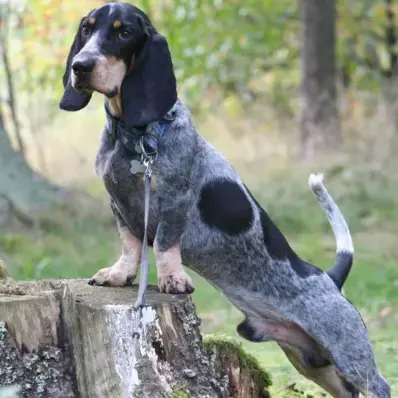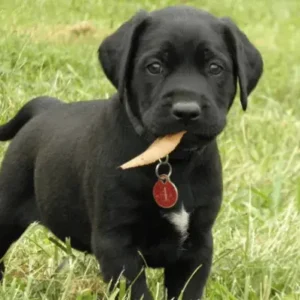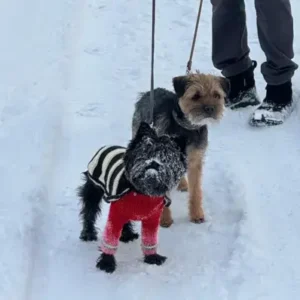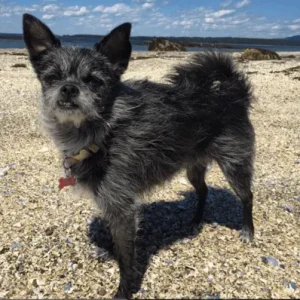Basset Bleu de Gascogne History/Origin
Originating in the Middle Ages, the Basset Bleu de Gascogne traces its lineage directly from the ancient Grand Bleu de Gascogne breed from the 12th century. Gaston III of Foix-Béarn, an esteemed figure in medieval hunting circles, is believed to have kept a pack of these hounds for hunting wild boar and wolves. The breed almost faced extinction in the 19th century when there was a decline in hunting interests. However, the breed was saved through the dedicated efforts of Alain Bourbon, ensuring its continued existence today. In 1991, the breed received recognition from the United Kennel Club in the United States. The Federation Cynologique Internationale (FCI) and UKC both list this breed as Scent Hounds.
Basset Bleu de Gascogne Personality
The Basset Bleu de Gascogne is a friendly and loving dog, known for its playful nature. Although they’re not aggressive, they do have a strong instinct to hunt small animals, a trait that comes naturally to them. These purebred dogs are quite vocal, often expressing themselves through barks and howls, which might not be suitable for apartment living where noise can be an issue.
- Basset Bleu de Gascogne Temperament
Being a hound dog, it is also quite energetic and loves to go on long walks. It requires daily exercise and physical stimulation, which is why it is well-suited for houses with backyards. 
- Potential challenges
Training a Basset Bleu de Gascogne can be challenging due to their strong inclination towards scent trails. Prospective owners can use various strategies to address this. Firstly, incorporating high-value rewards during training sessions can capture their attention and motivation. Keeping sessions short and engaging helps prevent boredom and maintain focus. Positive reinforcement techniques, such as praise and treats, reinforce desired behaviors. Consistency and patience are key. Understanding that mastery may take time is important. Initially, minimize distractions in the training environment. Gradually increase complexity to aid in successful training. By implementing these strategies, prospective owners can effectively address training challenges. This also helps build a strong bond with their Basset Bleu de Gascogne.
Basset Bleu de Gascogne Physical Appearance
The Basset Bleu de Gascogne is one of the dog breeds that presents a striking appearance, characterized by its distinct features and sturdy build. They are considered medium to large dogs but don’t have a heavy look to them. Their bodies are more on the lean and long side, with a deep chest. They have long ears that hang low and dark brown eyes.
- Size
This breed falls into the medium-sized category, with a low stature. On average, adult Basset Bleu de Gascognes stand between 12 to 15 inches at the shoulder. Typically, these dogs weigh between 35 to 40 pounds when fully matured.
- Coat Color
One of the most notable aspects of the Basset Bleu de Gascogne’s appearance is its captivating coat color. Their coat is predominantly white with blueish-black markings or black patches. They often have tan markings on their necks, eyes, and ears as well. Their short coat is of a smooth texture which is easy to groom.
White Basset Bleu de Gascogne with black patches – Source: bassetgascogne
Tricolor Basset Bleu de Gascogne – Source: Pinterest
White Basset Bleu de Gascognes with black markings – Source: Pinterest
In terms of appearance, there are similarities between the Basset Bleu de Gascogne and the Basset Hound.
| Characteristic | Basset Bleu de Gascogne | Basset Hound |
| Origin | France | France/United Kingdom |
| Size | Medium | Medium |
| Weight | 35-40 pounds (16-18 kg) | 40-65 pounds (18-29 kg) |
| Height | 12-15 inches (30-38 cm) | 11-15 inches (28-38 cm) |
| Coat | Short, dense | Short, smooth |
| Color | Mottled black and white (blue); both can have tricolor | Various, commonly tricolor or bicolor |
| Lifespan | 10-14 years | 10-12 years |
| Temperament | Friendly, intelligent, and independent | Gentle, affectionate, and sometimes stubborn |
Basset Hound – Source: Unsplash
Basset Bleu de Gascogne Gender Differences
Male Basset Bleu de Gascognes typically exhibit slightly larger physical proportions compared to females, but both genders share similar temperament traits.
Basset Bleu de Gascogne Feed/Nutrition
Maintaining a balanced diet is vital for the health and vitality of your Basset Bleu de Gascogne. Opt for high-quality dog food tailored to medium-sized breeds, supplemented with fresh, whole foods like lean meats and vegetables like cucumber. Consult your veterinarian for personalized feeding recommendations based on your dog’s age, weight, and activity level. Regular monitoring of weight and access to clean water are also crucial aspects of their nutrition regimen. By prioritizing proper nutrition, you can help your Basset Bleu de Gascogne thrive and lead a healthy life.
Basset Bleu de Gascogne Health Problems
Though generally healthy, the Basset Bleu de Gascogne can be susceptible to a few health concerns:
- Arthritis: As they age, Basset Bleu de Gascognes may develop arthritis, causing joint inflammation and discomfort. Managing weight and providing joint supplements can help alleviate symptoms.
- Canine Gastric Torsion: This breed, with its deep chest, can be prone to gastric dilatation, or bloat, a serious condition where the stomach fills with gas or fluid. Immediate veterinary attention is crucial if bloat is suspected to prevent life-threatening complications.
- Patellar Luxation: Patellar luxation, where the kneecap shifts out of place, can occur in Basset Bleu de Gascognes, leading to lameness and discomfort. While some cases may require surgery, mild instances can often be managed with medication and physical therapy.
Despite these potential health concerns, the Basset Bleu de Gascogne is known for its overall resilience and vitality. Regular veterinary check-ups, a balanced diet, exercise, and preventive care are crucial. With proper attention, many health issues in Basset Bleu de Gascognes can be managed effectively. This ensures they thrive and enjoy life fully. Prospective owners should work closely with their veterinarians. They need to ensure their Basset Bleu de Gascogne receives the necessary care and attention. This is essential for maintaining optimal health and well-being throughout their lives.
Basset Bleu de Gascogne Care and Grooming
Taking care of your Basset Bleu de Gascogne involves comprehensive grooming and attention to specific needs. Regular grooming sessions are essential, using a slicker brush to remove loose hair and prevent matting. Bathing should be done as needed with a mild dog shampoo. Due to their large, droopy ears, regular cleaning is necessary to prevent ear infections. Dental hygiene is crucial, requiring regular tooth brushing with dog-specific toothpaste. 
Basset Bleu de Gascogne Rescue Groups
If you’re considering adopting a Basset Bleu de Gascogne, there are rescue organizations dedicated to finding loving homes for this breed. Adopt-A-Griffon.EU
Basset Bleu de Gascogne Price
The price of a Basset Bleu de Gascogne typically ranges from $800 to $1,200, depending on the breeder and the dog’s pedigree. When looking to buy Basset Bleu de Gascogne puppies, make sure to find a responsible breeder who takes good care of their dogs and follows ethical standards. GunDogBreeders.com
Interesting Facts
- The Basset Bleu de Gascogne is one of several Basset breeds native to France, each distinguished by its unique characteristics and hunting abilities.
- Despite being a rare breed outside of France, the breed enjoys popularity among enthusiasts and hunters within its native country.
Best For
The Basset Bleu de Gascogne is an excellent companion, ideal for families seeking a friendly and affectionate pet. Their exceptional sense of smell also makes them adept at activities like scent work and search-and-rescue operations. 
Top Names
| Male Basset Bleu de Gascogne Names | Female Basset Bleu de Gascogne Names |
| Hugo | Aurélie |
| Max | Camille |
| Oliver | Geneviève |
| Charlie | Marguerite |
| Bentley | Sylvie |










 White Basset Bleu de Gascogne with black patches – Source:
White Basset Bleu de Gascogne with black patches – Source:  Tricolor Basset Bleu de Gascogne – Source:
Tricolor Basset Bleu de Gascogne – Source:  White Basset Bleu de Gascognes with black markings – Source:
White Basset Bleu de Gascognes with black markings – Source:  Basset Hound – Source:
Basset Hound – Source: 





